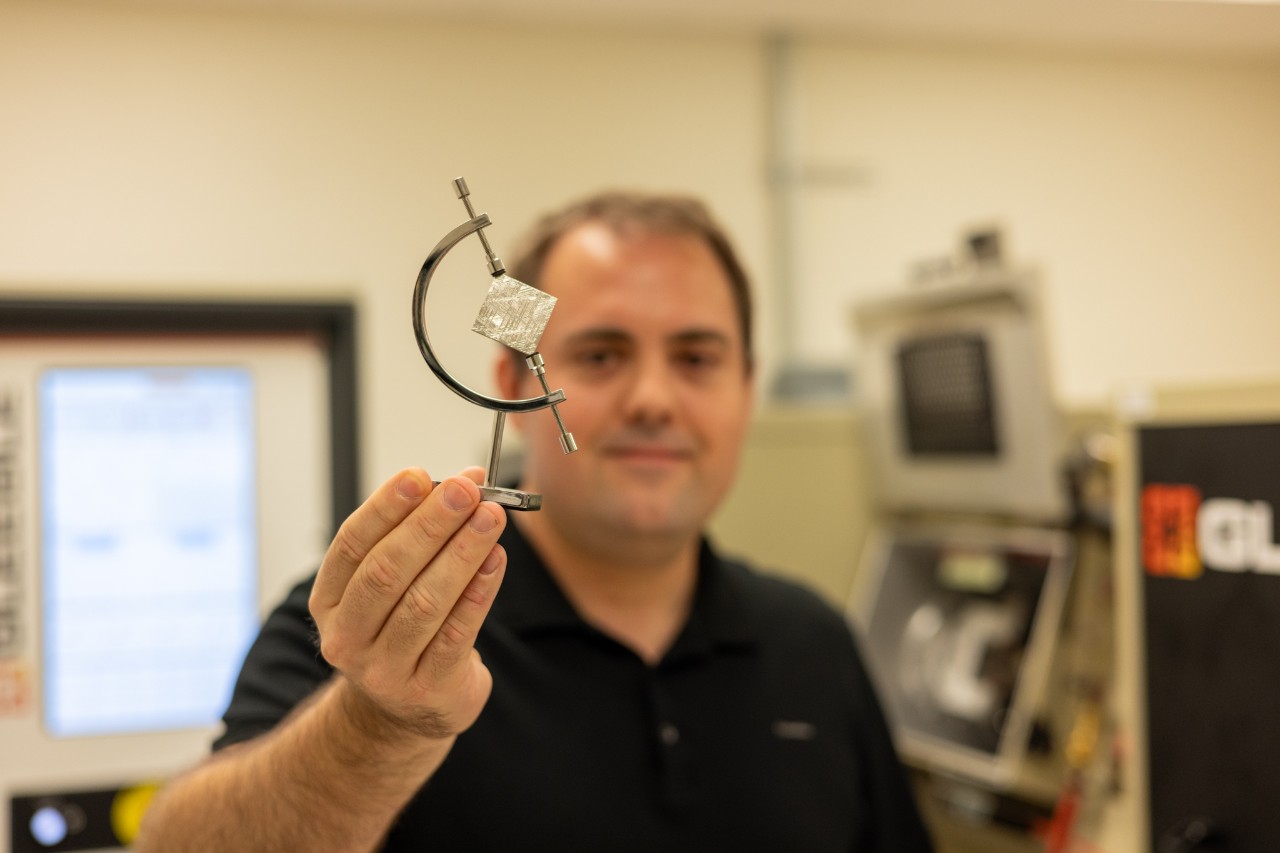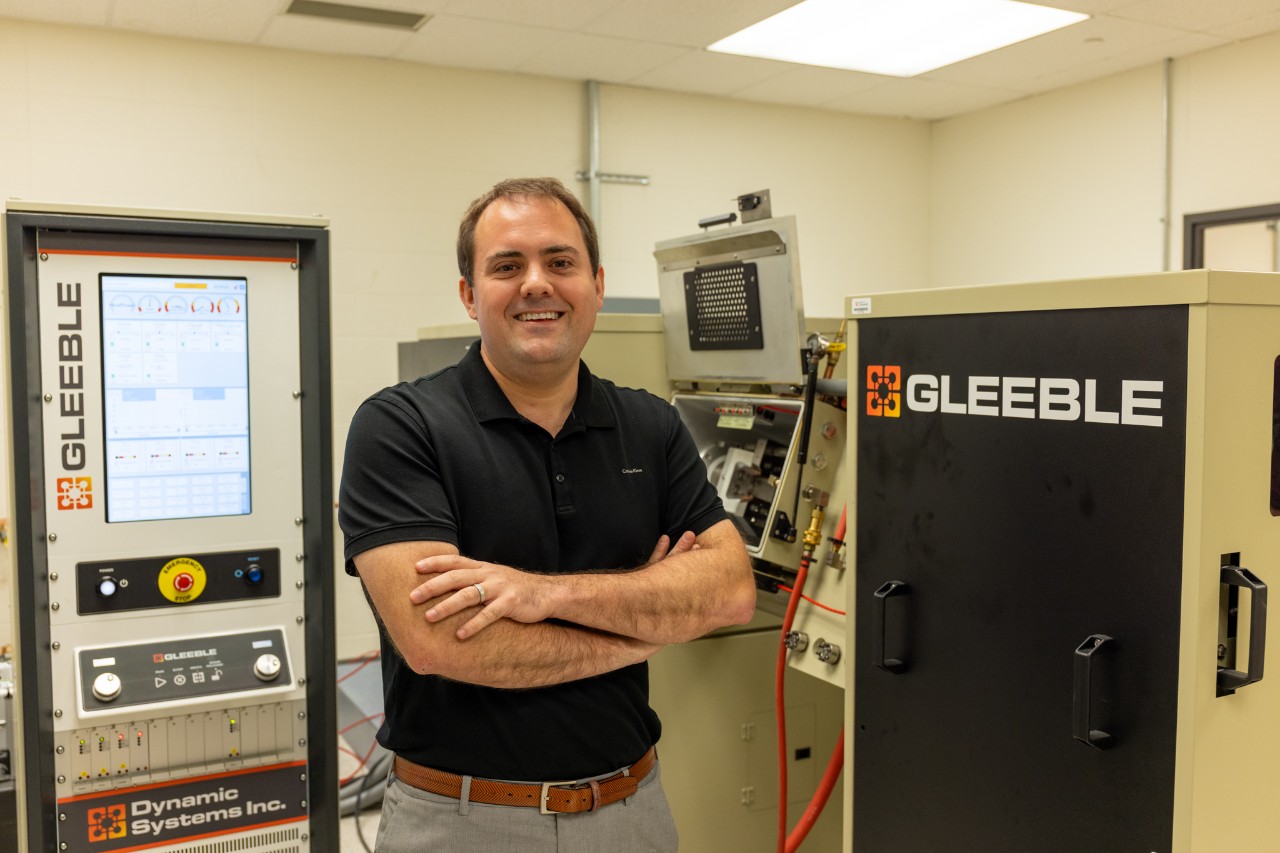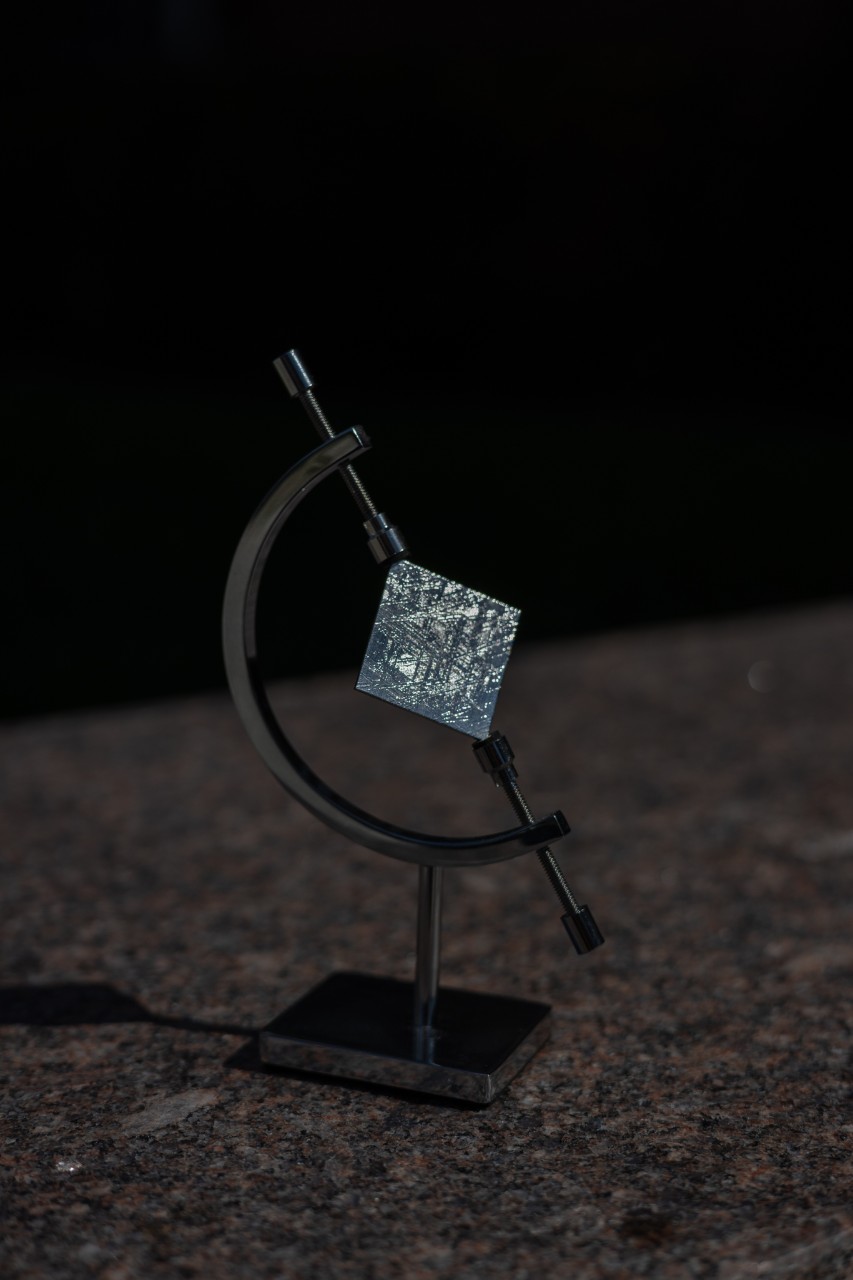
UC engineer explores better materials for clean energy solutions
Metals physicist awarded DoE Early Career grant to develop sustainable magnets for electric vehicles
As the world embraces sustainable transportation and clean energy, researchers at the University of Cincinnati are trying to solve the challenges of these growing technologies. Innovations like electric vehicles and wind turbines rely on high-strength permanent magnets to operate, but the scarcity of rare-earth elements in these magnets poses a significant obstacle.
Matt Steiner, assistant professor of materials science and engineering at UC’s College of Engineering and Applied Science (CEAS), is working to solve a piece of the puzzle that could lead to the development of more accessible alternative magnets.

Matt Steiner in his lab. Photo/Corrie Mayer/CEAS Marketing
“In materials science, we are always thinking about supply-limited materials,” Steiner said. “For example, in car batteries, lithium and cobalt are very supply limited. It’s one of the reasons why electrifying things has been such a challenge, because these low supply materials put a strain on the whole system.”
Steiner’s lab is focusing on the science behind the creation of a special type of iron-nickel magnet, called tetrataenite. Tetrataenite is the perfect replacement for the rare-earth magnets currently used in EVs and wind turbines because the materials are relatively abundant and have the necessary magnetic properties. However, it takes the atoms in iron-nickel millions of years to properly diffuse and become the ideal magnet. Steiner and his team are testing strategies to drastically accelerate this process in the lab to create this super-strong magnet in bulk for use in clean energy technologies.

A piece of a meteorite containing tetrataenite. Photo/Corrie Mayer/CEAS Marketing
When iron and nickel are melted and cast, the atoms start out in a jumble but eventually end up in what Steiner calls a “layer cake structure,” with a layer of iron alternating with a layer of nickel, and so on, which is the configuration required to rival the rare-earth magnets currently in use.
“The atoms are eventually going to order themselves the way we want, but we are exploring methods to encourage them to get there faster,” Steiner said. “So instead of millions of years, we can try and encourage it to happen in weeks or days.”
Scientists first discovered this tetrataenite layer-cake structure in meteorites over 50 years ago — Steiner keeps one in his lab for inspiration — and researchers have been trying to replicate its properties on Earth ever since.
Steiner received the prestigious Department of Energy Early Career Research Award in 2023, granting him $875,000 to continue this research project over the next five years.
While earning his bachelor’s in applied physics from Columbia University and his PhD from the University of Virginia in Charlottesville, Steiner developed an affinity for science that had more direct applications rather than more mathematical ones. During his undergraduate years, Steiner discovered an interest in physics, specifically nuclear and plasma physics, which set him on the trajectory leading him to where he is today. Now, through this DoE research grant, he hopes to share that inspiration and drive for direct scientific application with the next generation of students.
“This grant provides me the luxury to be able to sit down for five years with a PhD student to really focus on the work that we do, and it provides our students with opportunities that they otherwise may not have had before,” Steiner said.
In addition to his iron-nickel magnet research, Steiner is the primary adviser to four graduate students and has three undergraduate students that work in his lab. Recently, Steiner also completed research projects evaluating steel corrosion in bridges, sensitization of marine aluminum alloys, developing new nickel-based alloys for high temperature applications and analyzing uranium nuclear fuel alloys. He graduated his first PhD student this October.
“I’m hoping, if nothing else, that all of the work I do with my students establishes that materials science is a growing interdisciplinary field that is vital to our collective success in the world of science. A lot of people look at things like metallurgy as sort of dead fields, when they’re really not,” Steiner said.
Steiner is also honored to be a vital part of putting UC onto bigger stages in the research world. Steiner, along with Annette Rowe from biological sciences, was one of two professors from UC who received the Department of Energy grant this year. The Department of Energy only gives around 50 of these grants to university researchers every year, making Steiner’s award particularly noteworthy.
“As materials scientists, we are constantly researching and producing parts and materials that are vital to everything we need, from driving to manufacturing to flying. Our graduates have a high job placement rate because there are so many exciting and diverse applications for materials science that most people just aren’t exposed to at the college level. It’s important for people to know how important the work that we do is. I’m excited to keep pushing our knowledge further alongside my students over the next five years.”
Featured image at top: In his lab, Matt Steiner, assistant professor of materials science and engineering, holds an inspirational meteorite piece. Photo/Corrie Mayer/CEAS Marketing
Learn more about CEAS
Discover the research and academic advantages at the College of Engineering and Applied Science.
Related Stories
UC Research Ranking Climbs
January 10, 2002
The University of Cincinnati moved up in two different national rankings established by the National Science Foundation (NSF) to compare college and university research efforts.
Three of Four UC Fulbrights Scholars from McMicken
January 28, 2002
Tainted water supplies in Bangladesh, international security and missile defense, transformations in Mexico and greater understanding of India - this varied list sums up the work of four Fulbright Scholars at the University of Cincinnati who are concentrating on real-life issues involving our neighbors around the world.
Celebrating CAS' Deep Roots in Cincinnati
November 11, 2002
UC s College of Applied Science (CAS) is set to celebrate its rich heritage as the quiet cornerstone upon which Cincinnati industry, learning and culture has built itself since the school s founding on Nov. 20, 1828. The school was founded as the Ohio Mechanics Institute, the first school dedicated to technical education west of the Alleghenies. On Wednesday, Nov. 20, the college will toast its birth with a Founder s Day reception from 4:30-6:30 p.m. in the first floor of the CAS Administration Building, 2220 Victory Parkway.
Students Step Up to the Plate for this Final Exam
November 26, 2002
Civility is the main course for UC students set to take their final exam at Pigall's restaurant on December 4.
PROFILE: Teacher Bruce Bardes is Bulgaria Bound
February 9, 2003
A long-ago, childhood business is the reason UC faculty member Bruce Bardes will soon head off to Sofia, Bulgaria, to teach engineering courses as a Fulbright Exchange Scholar.
WISE Offers Summer Full of Science for Women
February 9, 2003
Undergraduate women interested in science can gain research experience and mentoring via UC's summer program.
Bridges Break in High School Competition at UC
February 13, 2003
Hundreds of high school seniors converge on the University of Cincinnati for the second annual bridge building competition.
Tug-of-War, Duct Tape Contests Highlight E-Week
February 17, 2003
During Engineering Week, UC students apply their knowledge to lighter topics, such as the structural dynamics of duct tape.
International Co-op: Much More Than a Visit Abroad
February 20, 2003
UC's International Co-op Program means living and working overseas, not just a brief trip.
Homeland Security Addressed in Seminar
February 24, 2003
A Feb. 27 lecture by the director of the National Homeland Security Research Center is free and open to the public.
